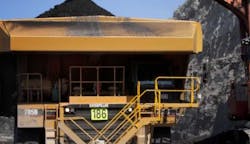Coal giant Peabody diving into Renewables for old mining sites
The world’s largest private-sector coal company is bowing to the times and embracing renewable energy for some of its old mining sites.
Peabody Energy is launching a new company called R3 Renewables LLC, pursuing development of solar and battery storage capacity in near-term projects. The R3 joint venture is teamed with financial firms Riverstone Credit Partners and Summit Partners Credit Advisors.
"We are pleased to announce this new joint venture as part of Peabody's commitment to be the coal producer of choice, creating additional value from our existing assets, supporting our own and our customers' ESG ambitions and providing added economic benefits for the communities in which we work and live," said Jim Grech, President and CEO of Peabody. "Both Riverstone and Summit Partners have deep experience across energy and growth sectors, and we believe R3 will benefit from their collective perspective on renewable energy solutions."
The 139-year-old Peabody, which was bankrupt and emerged from Chapter 11 reorganization nearly five years ago, is seeking to locate solar panels and battery storage at sites near or on former coal mining operations. The six prospective sites include former coal mines in Indiana and Illinois.
“As one of the world's largest private investment firms focused on energy, power, decarbonization and infrastructure, we believe we are well positioned to assist R3 Renewables to reclaim, reimagine and repower the region by pursuing these ambitious and transformative renewable energy projects,” Daniel Flannery, a Managing Director at Riverstone, said.
The R3 Renewables development goal is more than 3.3 GW of solar photovoltaic and 1.6 GW of battery storage over the next five years.
Peabody’s coal operations have emerged strong in recent periods despite the energy transition toward low carbon power. The St. Louis-based company reported more than $3.3 billion in revenue last year, more than 15 percent higher than the previous year’s earnings.
More than 4.5 million tons of coal were shipped in the seaborne thermal segment for the fourth quarter alone, Peabody reported. Most of those volumes were for the export market.
----
(Rod Walton, senior editor for EnergyTech, is a 14-year veteran of covering the energy industry both as a newspaper and trade journalist. He can reached at [email protected]).
About the Author
Rod Walton, EnergyTech Managing Editor
Managing Editor
For EnergyTech editorial inquiries, please contact Managing Editor Rod Walton at [email protected].
Rod Walton has spent 17 years covering the energy industry as a newspaper and trade journalist. He formerly was energy writer and business editor at the Tulsa World. Later, he spent six years covering the electricity power sector for Pennwell and Clarion Events. He joined Endeavor and EnergyTech in November 2021.
Walton earned his Bachelors degree in journalism from the University of Oklahoma. His career stops include the Moore American, Bartlesville Examiner-Enterprise, Wagoner Tribune and Tulsa World.
EnergyTech is focused on the mission critical and large-scale energy users and their sustainability and resiliency goals. These include the commercial and industrial sectors, as well as the military, universities, data centers and microgrids. The C&I sectors together account for close to 30 percent of greenhouse gas emissions in the U.S.
He was named Managing Editor for Microgrid Knowledge and EnergyTech starting July 1, 2023
Many large-scale energy users such as Fortune 500 companies, and mission-critical users such as military bases, universities, healthcare facilities, public safety and data centers, shifting their energy priorities to reach net-zero carbon goals within the coming decades. These include plans for renewable energy power purchase agreements, but also on-site resiliency projects such as microgrids, combined heat and power, rooftop solar, energy storage, digitalization and building efficiency upgrades.

